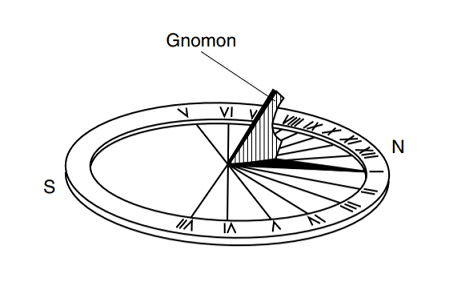
Topic Review: Solar System
Quiz by NYSED Earth Science
High School
Earth Science (1996) (Old upload)
New York State Learning Standards
Feel free to use or edit a copy
includes Teacher and Student dashboards
Measures 1 skill from
Measures 1 skill from
Track each student's skills and progress in your Mastery dashboards
With a free account, teachers can
- edit the questions
- save a copy for later
- start a class game
- automatically assign follow-up activities based on students’ scores
- assign as homework
- share a link with colleagues
- print as a bubble sheet
43 questions
Show answers
- Q1The diagram below represents a sundial positioned in New York State. During daylight, the shadow cast by the gnomon (pointer) moves across the disc, with the tip of the shadow pointing to the time of day. This motion of the gnomon's shadow on the sundial is mainly due toEarth's rotationthe Sun's revolutionthe Sun's rotationEarth's revolution30s4.1
- Q2The formation of the planet Uranus is estimated to have occurred approximately4.6 billion years ago2.0 billion years ago100,000 million years ago13.7 billion years ago30s4.1
- Q3Compared to the Jovian planets in our solar system, the terrestrial planets havemore mass and are less densemore mass and are more denseless mass and are more denseless mass and are less dense30s4.1
- Q4The diagram below represents the constellation Leo that can be seen by an observer in New York State at midnight during March. Leo is not visible to this observer at midnight during September becauseEarth has rotated on its axisLeo has rotated on its axisEarth has revolved in its orbit around the SunLeo has revolved in its orbit around the Sun30s4.1
- Q5An observer in New York City measured the angle of insolation at solar noon each day. During which month did this observer see the noontime angle of insolation increase each day?JulyDecemberSeptemberApril30s4.1
- Q6The Coriolis effect occurs as a result of Earth'srotationrevolutiontilted axismagnetic fi eld30s4.1
- Q7During the process of condensation, water vaporreleases 2260 J/g of heat energyreleases 334 J/g of heat energygains 2260 J/g of heat energygains 334 J/g of heat energy30s4.1
- Q8Infiltration is generally greater than runoff where the land has agentle slope and permeable soilsteep slope and impermeable bedrocksteep slope and permeable soilgentle slope and impermeable bedrock30s4.1
- Q930s4.1
- Q10The existence of which group of organisms spans the shortest geologic time?humansdinosaursbirdsplacoderm fish30s4.1
- Q11Which New York State geologic event occurred most recently?dome-like uplift of the Adirondack regionTaconian orogenyformation of the Catskill deltaGrenville orogeny30s4.1
- Q12The only dinosaur fossils found in New York State are footprints found on 210-million-yearold bedrock. In which New York State landscape region were these dinosaur fossils found?Tug Hill PlateauAdirondack MountainsAllegheny PlateauNewark Lowlands30s4.1
- Q13The photograph below shows a New York State index fossil. What is the best classification of this fossil, and during which geologic time period did the organism that produced this fossil exist?Classification: Trilobite Geologic time period: OrdovicianClassification: Coral Geologic time period: PermianClassification: Trilobite Geologic time period: PermianClassification: Coral Geologic time period: Ordovician30s4.1
- Q14Which table correctly indicates the solar times at locations A and B when it is 12 noon at location X?30s4.1
- Q1530s4.1
